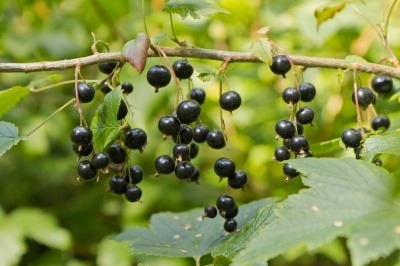
Blackcurrants remain one of the most enduring fruits with a distinctive green, fruity and highly unique recognizable aroma and flavour. Having studied the blackcurrant fruit for many years, this page is devoted to this unique food. The intention is to highlight the research conducted over the past 100 years into its uses, its sensory perception, processing and its uses, and its many nutritional benefits.
The blackcurrant (Ribes nigrum L.) is a member of the Saxifrage family. It is generally used in fruit juice beverages such as soft drinks, alcoholic beverages and jams. In the alcoholic beverages, it forms the distinctive product cassis. As a juice, it has a high acidity with a sugar content of 11.4g/100g (11.4 degree Brix). The acidity is contributed by 20 – 30% by weight of organic acids which is mostly citric acid and some malic acid on a fresh fruit, & about 30 – 50 % w/w of monosaccharide on the same basis.
Aroma Of Blackcurrant Fruit
Blackcurrant fruit aroma has been extensively researched and is made up of over 150 compounds, of which the major groups are terpenes, esters, and alcohols (Honkanen & Hirvi, 1990; Nijssen et al., 1996). Gas chromatography coupled with olfactometry (GC-O) has identified the major contributors to this aroma. The most important aroma compounds belong to the mono- and sesquiterpene groups. There is also diacetyl which is notably buttery, some esters such as the butyrates which give it the overall fruity character and a very distinctive compound – 4-methoxy-2-methyl-2-mercaptobutane, which gives certain varieties a catty or ‘tomcat’ note and is only found in trace amounts (Andersson & Von Sydow, 1964 & 1966; Bricout & Koziet, 1979; Kerslake & Menary, 1985; Marriott, 1987).
References
Andersson, J. and Von Sydow E. (1964) The aroma of blackcurrants. I. Higher boiling compounds. Acta Chem Scand 18 pp. 1105-1114 (Article)
_________________________(1966) The aroma of blackcurrants. II. Low boiling compounds. Acta Chem Scand 25 pp. 522-528
Bricout, J. and Koziet Y. (1979) Analysis of the aroma of different varieties of blackcurrant berries. Report 77.70.378, General Delegation on Technical and Scientific Research, Lyon.
Kerslake, M. F. and Menary, R. C. (1985) Aroma constituents of blackcurrant buds (Ribes nigrum L). Perfumer Flavourist 9 pp. 13-24
Marriott, R. J., (1987) Monoterpenes and sesquiterpenes in blackcurrant (Ribes nigrum L) berries: their distribution and changes during ripening, In: Flavour Science and Technology, Ed. by Martens M., Dalen G. A. and Russwurn Jr. H. , Wiley, Chichester, pp 57-62
Honkanen, E. and Hirvi, T. (1990) Chapter IV. The Flavour Of Berries. In: Food Flavours. Part C. The Flavour Of Fruits. Ed. Morton, I.D. and Macleod, A.J. Elsevier, Amsterdam. Section 8. pp. 168- 172
Nijssen, L.M., Visscher, C.A., Maarse, H., Willemsens, L.C. and Boelens, M.H. (1986). Blackcurrants (Berries and Buds). In: Volatile Compounds in Food, Qualitative and Quantitative Data: Fruits, Chapt. 7, pp.1-7.11. Second edition, TNO, Zeist.
Leave a Reply